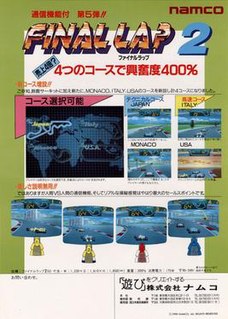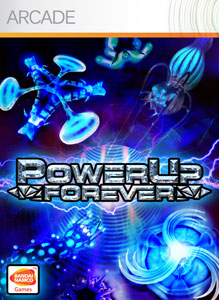 W
WActive Life: Extreme Challenge is a video game for the Wii platform, created by Bandai Namco Games. It is the sequel to the 2008 game Active Life: Outdoor Challenge and was released on August 11, 2009. The game uses a mat to play minigames. The game mat is different from the mat that is used in Dance Dance Revolution.
 W
WAttack of the Zolgear is an arcade game for one to six players released by Namco. It is a sequel to Galaxian 3. This game used two LaserDisc players simultaneously for the outer space background, while computer generated graphics were overlaid on top.
 W
WBlazer is an isometric perspective scrolling shooter arcade game that was released by Namco in 1987, only in Japan; it runs on the company's System 1 hardware, and used a three-quarter-view perspective.
 W
WDirt Fox is a racing arcade game, which had been released by Namco in 1989 only in Japan; it runs on Namco System 2 hardware, and allows up to four players to play simultaneously, when four cabinets are linked together they can allow up to eight players to play simultaneously, when four two-player cabinets are linked together.
 W
WEmeraldia is a puzzle arcade game released by Namco in 1993. On March 26, 2009, it was re-released on the Wii Virtual Console.
 W
WFighter & Attacker is a 1992 vertical-scrolling shooter arcade game developed and published by Namco.
 W
WFinal Lap 2 is an racing simulation game released by Namco for arcades in 1990. It is the arcade sequel to Final Lap and runs on Namco System 2 hardware.
 W
WFinal Lap 3 , as the name suggests, is the third title in the Final Lap series, released worldwide by Namco in 1992; like its precursors, it runs on Namco System 2 hardware, and allows up to eight players to play simultaneously when four two-player cabinets are linked together.
 W
WFinal Lap R is a racing arcade game which was released by Namco in 1994. It is the fifth game in the Final Lap series, and was licensed by FOCA to Fuji Television. Like its predecessors, it allows up to eight players to play simultaneously when four two-player cabinets are linked together - and it also features four new tracks set in Germany, Hungary, Belgium and Brazil.
 W
WFinest Hour is a 1989 run and gun arcade game developed and published in Japan by Namco. It was later re-released on the Wii Virtual Console on August 25, 2009.
 W
WFour Trax is a 1989 racing arcade game developed and published by Namco. It was released in North America by Atari Games, and was ported to the Mega Drive/Genesis in 1991 as Quad Challenge.
 W
WHello Kitty: Roller Rescue is a 2005 action-adventure-racing video game developed by XPEC Entertainment for the PlayStation 2, GameCube, Xbox, and Windows. The game features Hello Kitty and other Sanrio characters. The game also features additional character designs by Hunter Roberson and Rhett Deal.
 W
WMage Knight: Destiny's Soldier is a turn-based strategy video game for the Nintendo DS system based on the Wizkids Mage Knight tabletop game. It was produced by Namco and developed by Big Blue Bubble.
 W
WMappy Kids is a platform game sequel to the 1983 Namco/Midway arcade game Mappy. It was released for the Family Computer in Japan only.
 W
WMirai Ninja , is a side scrolling arcade game, released by Namco in 1988 exclusively in Japan. Mirai Ninja was adapted into the Japanese live-action film of the same name, which was also produced by Namco. The game runs on Namco System 2 hardware, and was the first Namco game which was adapted into a film.
 W
WMs. Pac-Man: Quest for the Golden Maze is a Microsoft Windows game published by Infogrames and released in 2001.
 W
WPac-Man and the Ghostly Adventures 2, also known in Japan as Pac-World 2 is a 2014 video game for the Wii U, Nintendo 3DS, Xbox 360 and PlayStation 3, released on October 14, 2014. It is the sequel to Pac-Man and the Ghostly Adventures.
 W
WPowerUp Forever is a downloadable multi-directional shooter developed by Blitz Arcade and published by Namco Bandai for the Xbox 360 via Xbox Live Arcade and the PlayStation 3 via PlayStation Network. It was released on Xbox Live Arcade on December 10, 2008 and the PlayStation Network on December 11, 2008. The title is a reference to the game Warning Forever, which was one of the influences for the game
 W
WPro Tennis: World Court is a tennis sports video game that was released by Namco in 1988 for Japanese arcades. It runs upon Namco System 1 hardware, and was inspired by the 1987 Famicom game Family Tennis. In August 1988, the game was ported to the PC Engine console, in which a new tennis-based role-playing quest mode was added, and was later ported to the North American TurboGrafx-16 console by NEC under the title of World Court Tennis in 1989. Up to four players could play simultaneously.
 W
WSteel Gunner 2 is a 1992 first-person shooter game developed and released by Namco for arcades. It is the sequel to Steel Gunner, which had been released in the previous year. It was also sold as a conversion kit for Taito's Operation Thunderbolt (1988).
 W
WSuper World Court is a tennis arcade game which was released by Namco in 1992 worldwide; it runs on Namco NA-1 hardware, and as the name suggests, it is the sequel to Pro Tennis: World Court which was released four years earlier. At the start of the game, players must select either "singles" or "doubles" - they will then have to select one of sixteen new players and select one of the four new courts. The players must then decide whether they want their match to be one or three sets long; the company's signature character, Pac-Man, also makes a cameo appearance upon the Namco court. A timer counts down from a maximum of 360 seconds in the top-right corner of the screen; if it has run out by the time a set has been won, the players will have to insert another coin within ten seconds if they wish to continue playing, because if they do not, the losing player shall immediately forfeit the game.
 W
WTamagotchi Connection: Corner Shop is a shop simulator game released by Bandai in 2006 for the Nintendo DS and has characters from the Tamagotchi series. It was later followed by Tamagotchi Connection: Corner Shop 2, released late that same year. The game requires the player to choose one of three Tamagotchi to run a store, playing a different mini-game for each store to serve customers.
 W
WTenkaichi Bushi Keru Nagūru is a fighting video game developed by Game Studio and published by Namco. It was released for the Famicom on July 21, 1989 only in Japan. It is one of the earliest versus fighting games with role-playing video game elements.